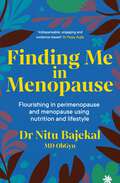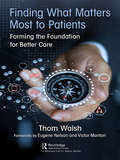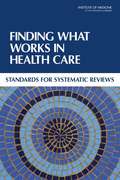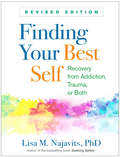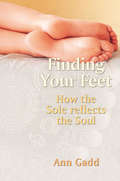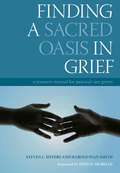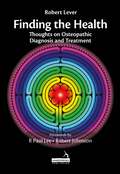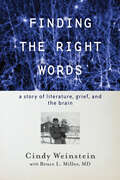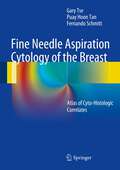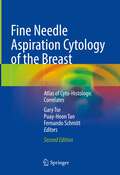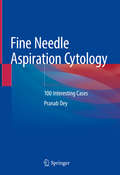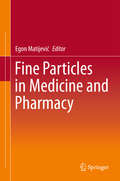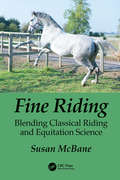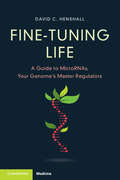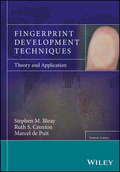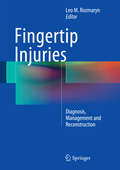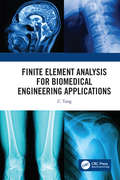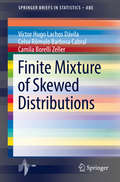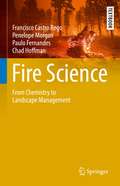- Table View
- List View
Finding Me in Menopause: Flourishing in Perimenopause and Menopause using Nutrition and Lifestyle
by Dr Nitu BajekalHRT is the one-stop solution for difficult menopause symptoms, we are told. But what if you don't want to take it? What if you can't take it? What if you can't get to a doctor? What if you can't get through to a doctor?In Finding Me in Menopause, Dr Nitu Bajekal, OBGYN, and one of the UK's first Board-Certified Lifestyle Medicine Physicians, shares how lifestyle interventions, and the food we eat, can dramatically transform menopausal health. following the principle of six lifestyle pillars, she gives simple yet scientific nutrition and lifestyle tips to transform the experience of menopause, with or without hormone therapy.Throughout her book, Dr Bajekal shows you how to lead a healthier and happier life, and make a positive difference for yourself and your loved ones, using time-tested techniques that anyone can access. You will learn how to identify and manage stress, understand how sleep affects our hormones, the role of exercise in our lives, and the importance of maintaining positive social connections for our mental health.There is dietary support, which draws on the science and power of plant-based nutrition to offer Menopause Menus - dozens of easy, delicious, and nourishing plant-based recipes for breakfast, main meals, and snacks from Nitu's kitchen with a shopping plan, and health insights for each dish.Each lifestyle pillar chapter concludes with a Menopause Mantra: a summary, a list of the top self-help tips to implement and a positive affirmation that is tied to that chapter.Finding Me In Menopause is an inclusive, non-pharmaceutical, holistic program that takes into account the needs of all women, from all backgrounds, removing the barriers that might stop you seeking support and giving you straightforward, achievable lifestyle-based strategies that will make a huge difference to your wellbeing.
Finding What Matters Most to Patients: Forming the Foundation for Better Care
by Thom WalshResearch shows that the importance of patient-reported outcomes, improved decision support, and care coordination is growing rapidly as new payment models transform healthcare delivery. This has led to the use of new measures and communication techniques, including shared decision-making and motivational interviewing. Using patient-reported outcomes at the point of service helps providers identify what matters most to the patient in front of them now. Describing treatment options and deciphering a patient’s preferences effectively is a process, which has been likened to arriving at a diagnosis. Providers make a medical diagnosis by discerning a patient’s primary complaints, past history, exam findings, and test results. A preference diagnosis can be thought of similarly. Providers work with their patients to identify what matters most to them, discuss the risks and benefits of the available treatment options, and support the patient as needed through the decision-making process. Once informed of their options, patients frequently chose treatments that require modifying their habits. Motivational interviewing helps patients and providers understand what matters most now and design care plans that provide appropriate support. While many healthcare providers and leaders may be familiar with patient-reported outcomes from research articles, and have heard of shared decision-making and motivational interviewing, few have experience using them. Fewer still understand how each relates to the other. This book helps leaders and healthcare providers better understand how to use patient-reported data to their advantage at the point of service. The book provides the background for developing shared knowledge and shared language, along with extensive examples of dialogue between providers and patients. In addition, the book contains personal interviews of subject matter experts who have significant experience using these measures. The result is a comprehensive understanding of how these measures and techniques can help providers, organizations, and patients navigate this modern healthcare management opportunity.
Finding What Works in Health Care: Standards for Systematic Reviews
by Institute of Medicine of the National AcademiesHealthcare decision makers in search of reliable information that compares health interventions increasingly turn to systematic reviews for the best summary of the evidence. Systematic reviews identify, select, assess, and synthesize the findings of similar but separate studies, and can help clarify what is known and not known about the potential benefits and harms of drugs, devices, and other healthcare services. Systematic reviews can be helpful for clinicians who want to integrate research findings into their daily practices, for patients to make well-informed choices about their own care, for professional medical societies and other organizations that develop clinical practice guidelines. Too often systematic reviews are of uncertain or poor quality. There are no universally accepted standards for developing systematic reviews leading to variability in how conflicts of interest and biases are handled, how evidence is appraised, and the overall scientific rigor of the process. In Finding What Works in Health Care the Institute of Medicine (IOM) recommends 21 standards for developing high-quality systematic reviews of comparative effectiveness research. The standards address the entire systematic review process from the initial steps of formulating the topic and building the review team to producing a detailed final report that synthesizes what the evidence shows and where knowledge gaps remain. Finding What Works in Health Care also proposes a framework for improving the quality of the science underpinning systematic reviews. This book will serve as a vital resource for both sponsors and producers of systematic reviews of comparative effectiveness research.
Finding Your Best Self, Revised Edition: Recovery from Addiction, Trauma, or Both
by Lisa M. NajavitsAddiction and trauma are two of the most common and difficult issues that people face. In this motivating book, leading expert Lisa Najavits explains the link between addiction and trauma and presents science-based self-help strategies that you can use no matter where you are in your recovery. Every chapter features inspiring words from people who have "been there," plus carefully designed reflection questions, exercises, and other practical tools. Learn how you can: *Build coping skills so that the future is better than the past. *Keep yourself safe and find support. *Set your own goals and make a plan to achieve them at your own pace. *Choose compassion over self-blame and shame. *Move toward your best self--the person you want to be. If you are a family member or friend seeking to support a loved one--or a helping professional--this book is also for you. Now in a convenient large-size format, the revised edition features added materials for professional and peer counselors. First edition title: Recovery from Trauma, Addiction, or Both. Mental health professionals, see also the author's Seeking Safety: A Treatment Manual for PTSD and Substance Abuse, which presents an evidence-based treatment approach developed specifically for PTSD and substance abuse.
Finding Your Emotional Balance: A Guide for Women (A Johns Hopkins Press Health Book)
by Merry Noel MillerA wise, empathetic guide to emotional and mental health for women of all ages.Women are twice as likely as men to become depressed. While they seek help for mental disorders more often than men, they also seek to help others, trying to keep everyone happy while taking care of parents, spouses, and children. Sometimes, doing it all is doing too much.In Finding Your Emotional Balance, Dr. Merry Noel Miller offers women of all ages advice for coping with life’s challenges while increasing its joys. Drawing on her three decades of experience as a psychiatrist specializing in women’s mental health—as well as her own personal struggles with depression and grief—she explains the special vulnerabilities and strengths of women during adolescence, the childbearing years, menopause, and late in life. Dr. Miller opens each chapter with stories about women who are dealing with issues related to their stage in life. She discusses common mental disorders in the context of life stages, exploring the symptoms of depression, anxiety, substance abuse, bipolar disorder, and unresolved grief. She also offers a variety of remedies, suggesting medical and nonmedical approaches to finding emotional balance even in the most stressful times. Each chapter ends with a list of suggested readings and websites.
Finding Your Feet
by Ann GaddExamining the mind-body connection in specific relation to the chakras and feet, this treatment manual will appeal to both holistic professionals and dabblers. Key issues and ailments are listed for each particular aspect of the foot, along with further explanations and case histories-including overall shape, shoes, broken nails, calluses, footprints, and bunions. The format and illustrations allow for quick reference as well as in-depth insight when required.
Finding Your Way to Change
by Stephen Rollnick William R. Miller Bonnie Gorscak Allan ZuckoffAre you tired of being told by others--self-help books included--what you should do? Drs. Allan Zuckoff and Bonnie Gorscak understand. That's why this book is different. Whether it's breaking an unhealthy habit, pursuing that dream job, or ending harmful patterns in relationships, the key to moving ahead with your life lies in discovering what direction is truly right for you, and how you can get there. The proven counseling approach known as motivational interviewing (MI) can help. Drs. Zuckoff and Gorscak present powerful self-help strategies and practical tools that help you understand why you're stuck, break free of unhelpful pressure to change, and build confidence for developing a personal change plan. Vivid stories of five men and women confronting different types of challenges illustrate the techniques and accompany you on your journey. MI has a track record of helping people resolve long-standing dilemmas in a remarkably short time. Now you can try it for yourself--and unlock your own capacity for positive action.
Finding a Family Next Door (Cotswold Docs)
by Louisa HeatonIn the second installment of Louisa Heaton&’s Cotswold Docs duet, two new doctor colleagues and next-door neighbors can&’t deny the chemistry between them, or the idea that their families&’ two halves could make a whole. IS LOVE CLOSER THAN SHE THINKS? GP Bella Nightingale needs a fresh start for herself and her little boy in the wake of a cheating ex. On her first day at Clearbrook Medical Practice, she discovers that her gorgeous colleague Dr. Max Moore is also a single parent—and her new neighbor! No stranger to loss, Max is as afraid of being hurt again as Bella, but the attraction between them is undeniable… Should they play it safe and avoid heartache, or could two and two make a perfect family of four?From Harlequin Medical: Life and love in the world of modern medicine. Cotswold DocsBook 1: Best Friend to Husband?Book 2: Finding a Family Next Door
Finding a Path to Safety in Food Allergy: Assessment of the Global Burden, Causes, Prevention, Management, and Public Policy
by Engineering Medicine National Academies of SciencesOver the past 20 years, public concerns have grown in response to the apparent rising prevalence of food allergy and related atopic conditions, such as eczema. Although evidence on the true prevalence of food allergy is complicated by insufficient or inconsistent data and studies with variable methodologies, many health care experts who care for patients agree that a real increase in food allergy has occurred and that it is unlikely to be due simply to an increase in awareness and better tools for diagnosis. Many stakeholders are concerned about these increases, including the general public, policy makers, regulatory agencies, the food industry, scientists, clinicians, and especially families of children and young people suffering from food allergy. At the present time, however, despite a mounting body of data on the prevalence, health consequences, and associated costs of food allergy, this chronic disease has not garnered the level of societal attention that it warrants. Moreover, for patients and families at risk, recommendations and guidelines have not been clear about preventing exposure or the onset of reactions or for managing this disease. Finding a Path to Safety in Food Allergy examines critical issues related to food allergy, including the prevalence and severity of food allergy and its impact on affected individuals, families, and communities; and current understanding of food allergy as a disease, and in diagnostics, treatments, prevention, and public policy. This report seeks to: clarify the nature of the disease, its causes, and its current management; highlight gaps in knowledge; encourage the implementation of management tools at many levels and among many stakeholders; and delineate a roadmap to safety for those who have, or are at risk of developing, food allergy, as well as for others in society who are responsible for public health.
Finding a Sacred Oasis in Grief: A Resource Manual for Pastoral Care Givers
by Harold Ivan Smith Steven JeffersThis work includes a foreword by John D Morgan, Professor Emeritus of Philosophy, Coordinator for Kings College Center for Education about Death and Bereavement, Ontario, Canada. This practical resource guides the reader though all aspects of the grieving process and offers thought-provoking and inspirational advice on support. With exercises, tips, and contacts for further assistance, "Finding a Sacred Oasis in Grief" provides a comprehensive understanding of this potentially difficult and complex topic. It examines different types of grief and various approaches, along with reference guides to particular religions and their traditions adopting a comprehensive, multi-faith approach. Pastoral care providers and religious leaders will find the unique, hands-on approach invaluable, as will members of support organisations and volunteer carers. It is also ideal for seminary and ministry students, counsellors, therapists and other care professionals. "Gives caregivers the tools to help dying and grieving persons face the best and worst that life has to offer. It is the worst, because death means the end of the attachments that make life worthwhile. It is the best, because it shows us what is truly meaningful and important in life. Mortality is a great gift if we have the knowledge and the courtesy to face it." - John D Morgan, in the Foreword.
Finding the Edge: Finding The Edge (colby Agency: Sexi-er, Book 1) / Undercover Scout (apache Protectors: Wolf Den, Book 3) (Colby Agency: Sexi-ER #1)
by Debra WebbThere’s a target on her back. And only he can save her. A scorching Colby Agency romance from the USA Today–bestselling author of Sin and Bone.How can his latest assignment not be personal? Bodyguard Todd Christian has been hired to protect ER nurse Eva Bowman. Not only has she been marked for death by a dangerous gang, but she’s also the woman Todd has never been able to forget. He chose to walk away from her—and the heat between them—once. That’s not a mistake Todd is making again.“Debra Webb is a master storyteller!” —Allison Brennan, New York Times–bestselling author“Debra Webb’s name says it all!” —Karen Rose, New York Times–bestselling author
Finding the Health: Thoughts on Osteopathic Diagnosis and Treatment
by Robert LeverThe art of osteopathy has always been based on a body of anatomical and physiological theory and data but it has recently been expanded in exciting ways involving contemporary thinking in physics and biology that tell us more about disease causation and tissue function. This book brings these two fields of thinking together.The author is now recognised as deep thinker in the field of osteopathy and has developed an international following since the publication of his first book At the Still Point. He puts into clear and understandable prose the ideas and feelings that many osteopaths experience but find difficult to express.The application of concept, theory and, above all, principle, is the real challenge and it is by addressing these with penetration and relevance that the book allows the practitioner to 'find the health' rather than merely attempting to confront disease.
Finding the Right Words: A Story of Literature, Grief, and the Brain
by Cindy WeinsteinThe moving story of an English professor studying neurology in order to understand and come to terms with her father's death from Alzheimer's.In 1985, when Cindy Weinstein was a graduate student at UC Berkeley, her beloved father, Jerry, was diagnosed with early-onset Alzheimer's disease. He was fifty-eight years old. Twelve years later, at age seventy, he died having lost all of his memories—along with his ability to read, write, and speak. Finding the Right Words follows Weinstein's decades-long journey to come to terms with her father's dementia as both a daughter and an English professor. Although her lifelong love of language and literature gave her a way to talk about her grief, she realized that she also needed to learn more about the science of dementia to make sense of her father's death. To write her story, she collaborated with Dr. Bruce L. Miller, neurologist and director of the Memory and Aging Center at the University of California, San Francisco, combining personal memoir, literature, and the science and history of brain health into a unique, educational, and meditative work. Finding the Right Words is an invaluable guide for families dealing with a life-changing diagnosis. In chapters of profound and sometimes humorous remembrance, Weinstein relies on literature to describe the shock of her father's diagnosis and his loss of language and identity. Writing in response to Weinstein's deeply personal narrative, Dr. Miller describes the neurological processes responsible for the symptoms displayed by her father. He also reflects upon his own personal and professional experiences. In a final chapter about memory, Weinstein is able to remember her father before the diagnosis, and Miller explains how the brain creates memories while sharing some of his own. Their two perspectives give readers a fuller understanding of Alzheimer's than any one voice could.
Fine Needle Aspiration Cytology of the Breast
by Fernando Schmitt Gary Tse Puay Hoon TanThis book provides a detailed update on all aspects of fine-needle aspiration cytology of breast lesions. It will serve readers as an up-to-date reference and atlas on both new entities in breast pathology, including borderline lesions such as flat epithelial atypia, and the classic benign and malignant lesions. Throughout, emphasis is placed on the characteristic diagnostic features as well as the common pitfalls faced by cytologists. As cytologic features can be highly variable, corresponding cytology and histology images are displayed together, enabling readers to gain a good understanding of the morphologic features of various lesions. Core-needle biopsy and fine-needle aspiration cytology are compared in depth, with attention to their relative strengths and weaknesses and indications. In addition, the impact of molecular classification of breast cancers on cytologic diagnosis is explored, and the use of molecular techniques in diagnostic cytology is discussed.
Fine Needle Aspiration Cytology of the Breast: Atlas of Cyto-Histologic Correlates
by Fernando Schmitt Gary Tse Puay-Hoon TanThis book provides a detailed update on all aspects of fine-needle aspiration cytology of breast lesions. It will serve as an up-to-date reference and atlas on new entities in breast pathology, including classic benign and malignant lesions, in accordance with current classification schemes and staging protocols. Emphasis is placed on description of characteristic diagnostic features as well as common cytological pitfalls. Correlation of cytology with histology is achieved through cyto-histological illustrations, enabling readers to gain a good understanding of the morphologic features of various lesions. Core-needle biopsy and fine-needle aspiration cytology are compared in depth, with attention to their relative strengths and weaknesses and indications. In addition, the impact of molecular classification of breast cancers on cytologic diagnosis is explored, and the use of molecular techniques and artificial intelligence in diagnostic cytology is discussed.
Fine Needle Aspiration Cytology: 100 Interesting Cases
by Pranab DeyThis book discusses a broad selection of interesting cases of fine needle aspiration cytology (FNAC), which offer valuable insights into the diagnosis of cytology cases in routine practice. It provides the salient clinical history along with representative microphotographs of the routine smears. The content is divided into 100 chapters, with each chapter covering an individual case in detail. The book also addresses immunocytochemistry and other ancillary techniques that can help to diagnose lesions. Richly illustrated with more than 900 images, the book offers a valuable guide to diagnosis and self-evaluation for students/trainees/examinees of pathology and cytology practitioners alike.
Fine Particles in Medicine and Pharmacy
by Egon MatijevićPharmaceutical manufacture is very exacting - for example, drugs must be uniform in size, shape, efficacy, bioavailability, and safety. The presence of different polymorphs in drug production is a serious problem, since different polymorphs differ in bioavailability, solubility, dissolution rate, chemical and physical stability, melting point, color, filterability, density, and flow properties. Fine Particles in Medicine and Pharmacy discusses particle size, shape, and composition and how they determine the choice of polymorph of a drug.
Fine Riding: Blending Classical Riding and Equitation Science
by Susan McBaneEquitation Science together with classical riding is today probably the most humane, effective, and practical way of training and enjoying the horse, competitive or not. To avoid getting involved is to accede to the status quo. Our horses deserve better.~Sharon E. Cregier, Ph.D., FIASH (Hon., Edin.), founding member of Equine Behaviour Forum In precise, practical language, Fine Riding describes how to blend the principles of classical riding with the modern findings of Equitation Science, demonstrating how to put the principles into practice when training and riding horses. The book encompasses the author's lifelong background in authentic classical riding and a 17-year study and practice of Equitation Science. It presents the best of the old with the best of the new, resulting in a unique and rational blend of principles, clearly explained, that enables and encourages readers to train, ride and care for their horses truly effectively and humanely. Applicable to riding of all schools of thought, from hacking to racing, including jumping, McBane's method is more than simply another ‘system’ of riding. It applies the results of rigorous scientific studies to the historical, classical training and riding of horses in an ethical, humane and effective way, explaining the principles in such a way that readers will feel able to put it into effect themselves. This book will encourage horse owners to serve their horses with renewed understanding and commitment.
Fine-Tuning Life: A Guide to MicroRNAs, Your Genome's Master Regulators
by David C. HenshallTake a journey into the fascinating world of microRNA, the genome's master controllers. Discovered in 1993, our genome's master controllers are critical to the evolution of complex life, including humans. This captivating book tells their story, from their discovery and unique role in regulating protein levels to their practical applications in brain health and other branches of medicine. Written by a neuroscientist, it provides an in-depth look at what we know about microRNAs and how we came to know it. Explore the impact of these molecular conductors on your life and gain a new appreciation for the precision they bring to the molecular noise in our cells. Perfect for students of neuroscience, life sciences such as biochemistry and genetics and the curious public alike, this is the captivating tale of the conductors of life's molecular orchestra.
Fingerprint Development Techniques: Theory and Application (Developments in Forensic Science)
by Stephen M. Bleay Ruth S. Croxton Marcel De PuitA comprehensive review of the latest fingerprint development and imaging techniques With contributions from leading experts in the field, Fingerprint Development Techniques offers a comprehensive review of the key techniques used in the development and imaging of fingerprints. It includes a review of the properties of fingerprints, the surfaces that fingerprints are deposited on, and the interactions that can occur between fingerprints, surfaces and environments. Comprehensive in scope, the text explores the history of each process, the theory behind the way fingerprints are either developed or imaged, and information about the role of each of the chemical constituents in recommended formulations. The authors explain the methodology employed for carrying out comparisons of effectiveness of various development techniques that clearly demonstrate how to select the most effective approaches. The text also explores how techniques can be used in sequence and with techniques for recovering other forms of forensic evidence. In addition, the book offers a guide for the selection of fingerprint development techniques and includes information on the influence of surface contamination and exposure conditions. This important resource: Provides clear methodologies for conducting comparisons of fingerprint development technique effectiveness Contains in-depth assessment of fingerprint constituents and how they are utilized by development and imaging processes Includes background information on fingerprint chemistry Offers a comprehensive history, the theory, and the applications for a broader range of processes, including the roles of each constituent in reagent formulations Fingerprint Development Techniques offers a comprehensive guide to fingerprint development and imaging, building on much of the previously unpublished research of the Home Office Centre for Applied Science and Technology.
Fingertip Injuries
by Leo M. RozmarynFocusing exclusively on the various categories of injury to the fingertip - the most common orthopedic injury seen in the ER - this book covers anatomy, physiology, mechanisms of injury, treatment options and outcomes, and possible complications stemming from these treatments. Management strategies discussed in this book range from simple splinting to complex microvascular reconstruction, open reduction internal fixation (ORIF), complex nail reconstruction, decompression of high pressure injection injuries, local and regional flap reconstructions, and free tissue transfers for fingertip coverage. Additional topics include the management of fingertip burns (thermal, chemical and electrical, and frostbite) as well as special considerations in pediatric fingertip injuries and rehabilitation strategies. It will be an essential reference for orthopedic and hand surgeons, as well as plastic, trauma and emergency surgeons and their staff at work in the ER.
Finite Element Analysis for Biomedical Engineering Applications
by Z. C. YangFinite element analysis has been widely applied to study biomedical problems. This book aims to simulate some common medical problems using finite element advanced technologies, which establish a base for medical researchers to conduct further investigations. This book consists of four main parts: (1) bone, (2) soft tissues, (3) joints, and (4) implants. Each part starts with the structure and function of the biology and then follows the corresponding finite element advanced features, such as anisotropic nonlinear material, multidimensional interpolation, XFEM, fiber enhancement, UserHyper, porous media, wear, and crack growth fatigue analysis. The final section presents some specific biomedical problems, such as abdominal aortic aneurysm, intervertebral disc, head impact, knee contact, and SMA cardiovascular stent. All modeling files are attached in the appendixes of the book. This book will be helpful to graduate students and researchers in the biomedical field who engage in simulations of biomedical problems. The book also provides all readers with a better understanding of current advanced finite element technologies. Details finite element modeling of bone, soft tissues, joints, and implants Presents advanced finite element technologies, such as fiber enhancement, porous media, wear, and crack growth fatigue analysis Discusses specific biomedical problems, such as abdominal aortic aneurysm, intervertebral disc, head impact, knee contact, and SMA cardiovascular stent Explains principles for modeling biology Provides various descriptive modeling files
Finite Mixture of Skewed Distributions (SpringerBriefs in Statistics)
by Víctor Hugo Lachos Dávila Celso Rômulo Cabral Camila Borelli ZellerThis book presents recent results in finite mixtures of skewed distributions to prepare readers to undertake mixture models using scale mixtures of skew normal distributions (SMSN). For this purpose, the authors consider maximum likelihood estimation for univariate and multivariate finite mixtures where components are members of the flexible class of SMSN distributions. This subclass includes the entire family of normal independent distributions, also known as scale mixtures of normal distributions (SMN), as well as the skew-normal and skewed versions of some other classical symmetric distributions: the skew-t (ST), the skew-slash (SSL) and the skew-contaminated normal (SCN), for example. These distributions have heavier tails than the typical normal one, and thus they seem to be a reasonable choice for robust inference. The proposed EM-type algorithm and methods are implemented in the R package mixsmsn, highlighting the applicability of the techniques presented in the book.This work is a useful reference guide for researchers analyzing heterogeneous data, as well as a textbook for a graduate-level course in mixture models. The tools presented in the book make complex techniques accessible to applied researchers without the advanced mathematical background and will have broad applications in fields like medicine, biology, engineering, economic, geology and chemistry.
Fire Science: From Chemistry to Landscape Management (Springer Textbooks in Earth Sciences, Geography and Environment)
by Francisco Castro Rego Paulo Fernandes Penelope Morgan Chad HoffmanThis textbook provides students and academics with a conceptual understanding of fire behavior and fire effects on people and ecosystems to support effective integrated fire management. Through case studies, interactive spreadsheets programmed with equations and graphics, and clear explanations, the book provides undergraduate, graduate, and professional readers with a straightforward learning path. The authors draw from years of experience in successfully teaching fundamental concepts and applications, synthesizing cutting-edge science, and applying lessons learned from fire practitioners. We discuss fire as part of environmental and human health. Our process-based, comprehensive, and quantitative approach encompasses combustion and heat transfer, and fire effects on people, plants, soils, and animals in forest, grassland, and woodland ecosystems from around the Earth. Case studies and examples link fundamental concepts to local, landscape, and global fire implications, including social-ecological systems. Globally, fire science and integrated fire management have made major strides in the last few decades. Society faces numerous fire-related challenges, including the increasing occurrence of large fires that threaten people and property, smoke that poses a health hazard, and lengthening fire seasons worldwide. Fires are useful to suppress fires, conserve wildlife and habitat, enhance livestock grazing, manage fuels, and in ecological restoration. Understanding fire science is critical to forecasting the implication of global change for fires and their effects. Increasing the positive effects of fire (fuels reduction, enhanced habitat for many plants and animals, ecosystem services increased) while reducing the negative impacts of fires (loss of human lives, smoke and carbon emissions that threaten health, etc.) is part of making fires good servants rather than bad masters.
Fire and Bones (A Temperance Brennan Novel #23)
by Kathy Reichs#1 New York Times bestselling author Kathy Reichs returns with a twisty, unputdownable thriller featuring forensic anthropologist Temperance Brennan, who finds herself at the centre of a Washington, D.C., arson investigation that spawns deepening levels of mystery and, ultimately, violence. Always apprehensive about working fire scenes, Tempe is called to Washington, D.C., to analyse the victims of a deadly blaze and sees her misgivings justified. The devastated building is in Foggy Bottom, a neighbourhood with a colourful past and present, and Tempe becomes suspicious about the property&’s ownership when she delves into its history. The pieces start falling into place strangely and quickly, and, sensing a good story, Tempe teams up with a new ally, telejournalist Ivy Doyle. Soon the duo learns that back in the thirties and forties the home was the hangout of a group of bootleggers and racketeers known as the Foggy Bottom Gang. Though interesting, this fact seems irrelevant – until the son of a Foggy Bottom gang member is shot dead at his home in an affluent part of the district. Coincidence? Targeted attacks? So many questions. As Tempe and Ivy dig deeper, an arrest is finally made. Then another Foggy Bottom Gang-linked property burns to the ground, claiming one more victim. Slowly, Tempe&’s instincts begin pointing to the obvious: somehow, her moves since coming to Washington have been anticipated, and every path forward seems to bring with it a lethal threat.
